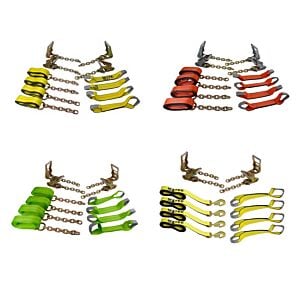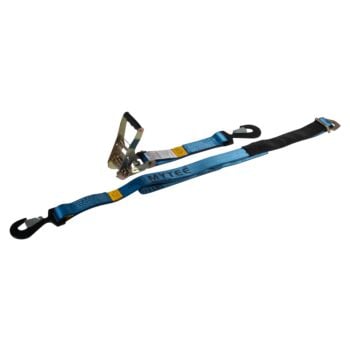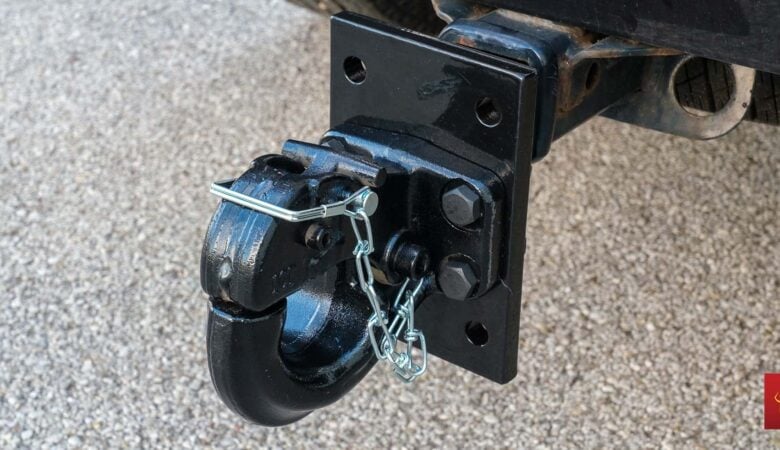It’s a risk that lingers in the back of every car hauler’s mind: that a sudden stop or lane change is the only thing between a safe delivery and damaged cargo. Regardless of the type of loads you haul, having car tie-down straps at your disposal is incredibly important for ensuring your cargo is always delivered safely, no matter what happens on the road!
Tire straps are available in an array of types, some designed to fit over tires and other objects in ways that are beneficial to some haulers but detrimental to others. Additionally, all car tire straps come in different working load limits. For example, having a light-duty strap with a low load limit is perfect if you are transporting objects like light furniture, but these straps cannot be used efficiently to keep a vehicle in place during transport.
Trying to navigate the overwhelming amount of information out there about tire straps can feel like a lost cause, especially if you haul a variety of vehicles or are new to the car hauling industry. What are Tie Down Straps Types available in the market? What’s the best tire strap for you? How many tie-down straps do you need per load? At Mytee Products, we are happy to help make the process easier by putting everything you need to know into one article! Welcome to our complete guide to Car Tie Down Straps Uses and Types!
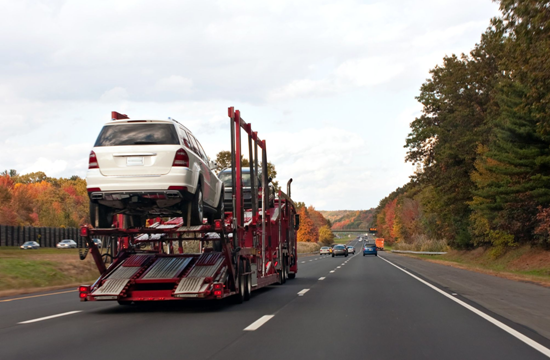
Tire Straps are Made from Which Material and Why It Matters?
One of the most common materials used to make car hauler straps is polyester webbing. Polyester webbing has the unique qualities of remarkable durability, resistance to abrasions and cuts, and water slides off easily to prevent the growth of mildew! Polyester webbing tire straps are designed to easily secure vehicles and cargo to your trailer without too much stretching, but it is important to remember that while polyester webbing may not stretch much that doesn’t mean they will not stretch at all.
During use, car hauler straps can stretch up to 3%, which may not seem like a lot but that percentage will add up after each use! Be sure that you’re checking your straps before every use for the risk of the webbing snapping, or breaking! The quality of your tire tie-down straps may increase or decrease the amount of this percentage, but having good quality tire straps goes beyond preferences about stretching percentages or cargo safety. It’s also a matter of following the law and regulations!
The Federal Motor Carrier Safety Administration requires car tie-down straps to be of specific and sufficient strength when securing cargo. If you use car tire straps on both ends of your trailer or flatbed – also called indirect tie-downs – the working load limit must be half of the total weight of the cargo you’re hauling. For direct tie-downs, in which you’re directly securing cargo to your trailer, the strap’s working load limit must equal the weight of the load.
Also Read: Know the Direct and Indirect Tie-Downs
Additionally, your car hauler straps must be free of knots or twists and be secured in a way that prevents them from coming undone or loose while remaining easily adjustable so that you can quickly tighten or loosen them on the road.

Typically, the minimum number of Transport straps you need is dependent on the size and weight of your cargo. When you are hauling vehicles, however, you should have one tire tie-down strap per tire for ample security and reassurance that the vehicle will remain stable. For other types of cargo, objects less than 5 feet long and weighs less than 1,100 lbs will typically only need one tie-down strap. For objects longer than 5 feet or more than 1,100 lbs, you’ll need more straps. No matter the type of cargo or vehicle you haul, always make sure you are not exceeding your car trailer straps working load limits! Remember: there is no such thing as too many tie-down straps!
How to Use Car Tie-Down Straps:
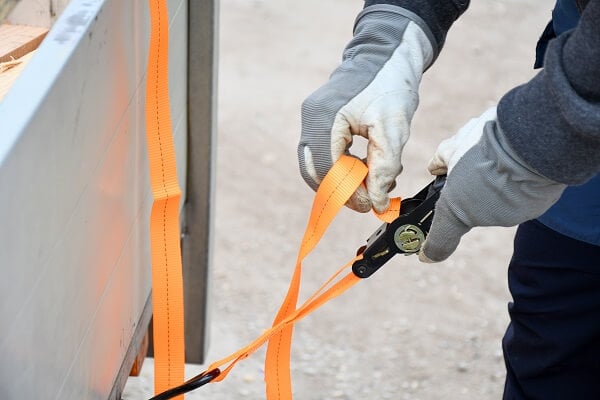
Time needed: 5 minutes
Learning how to properly secure your car tire straps is the knowledge required of all auto haulers. Your cargo can be severely damaged or worse if the tire straps are incorrectly secured. You risk not just putting yourself in danger should the cargo roll forward and hit the cab of your vehicle, but you risk the safety of other motorists on the road too. The steps below will help keep you and your vehicle loads safe:
- Secure Straps in the Right Spot:
Different Vehicle straps for the trailer must be applied in specific ways. Axle straps, for example, must be attached to the vehicle’s front and rear axles. Ratchets can be added to any strap to increase tension and tighten the straps, but they need to be connected to a point of suspension, NOT onto the body of the car. Do not ever attach a tire strap to a steering component or fuel/brake line, and avoid wrapping car hauling straps around wires or brake lines as they can be broken or damaged during transit.
- Tightening Trailer Tie-Down Straps:
Most tire straps can be attached to a ratchet system. These instructions are for ratcheting the straps, as we will go into further detail about specific car hauling straps in the next section.
First, thread the end of the webbing through the slot in the center spool of the ratchet. Then pull the webbing end back in the same direction it just came from and pull again to remove slack. Finally, increase the strap’s tension by moving the ratchet handle up and down until it’s reached the proper tension for your cargo or tire. - Verify Strap Security:
Once the vehicle’s tire straps are secure and you’ve begun your drive, stop periodically at rest stops or gas stations every 10-20 miles, especially if your car hauling straps are brand new. New polyester car tire straps may be more prone to stretching out during first-time use. Testing your straps for tightness and making any adjustments is good practice for any cargo hauler. Once you’ve ensured all tire straps are secure and tight, you can get back on the road and repeat the process throughout the trip. However, it’s recommended to also check your tire straps after any sharp maneuvers or sudden stops to make sure they hadn’t come loose, damaged, or broken.
- Loosening Trailer Tie-Down Straps:
When releasing these straps, search for the release tab near the handle and pull it to override the ratcheting system. Keep the tab open until the strap is lying flat and pull the webbing back through the spool as far as you need to unhook the strap safely from the trailer, and begin unloading your cargo.
Types of Car Tie-Down Straps:
While this isn’t a complete list of all car trailer straps, these are the ones that you will most likely come across or use. If you have any questions regarding Car Tie Down Straps Uses and Types, feel free to contact us and we’ll be happy to assist you and answer any questions!
1. Over-the-Wheel Straps:
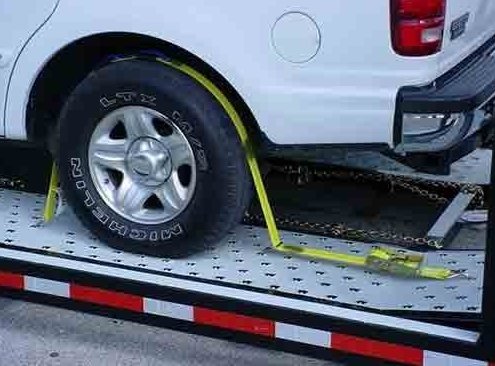
One of the most common auto hauling straps you may be familiar with is the over-the-wheel strap! While other tire straps, like the lasso wheel straps, have between one or two tie-down points, over-the-wheel straps are designed with two anchor points. However, because of this design, these trailer straps can only be attached to trailers or car beds that have floor anchor points. However, if you want to use over-the-wheel straps and lack floor tie-down points, you can invest in E-track systems as a solution!
2. Tow Dolly Wheel Straps:

Also called basket straps, these car tire tie-down straps are designed to fit around the wheel of the vehicle for a secure yet adjustable fit, so they’re able to be used on a variety of tire sizes! Tow dolly wheel straps hold the wheels snug and prevent any sliding that happens with single straps.
3. Side Mount Wheel Nets:
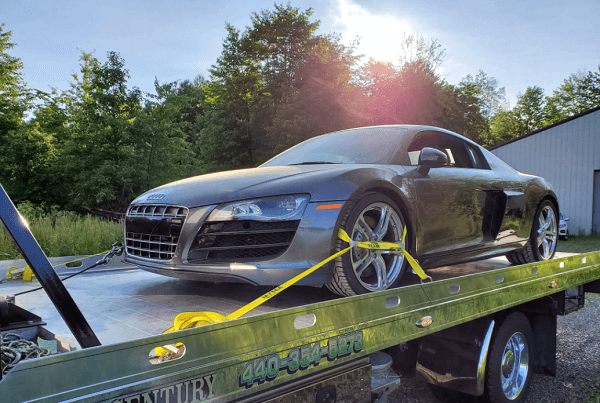
Designed to go around the outside of the vehicle’s tires, these tire straps create a great securement point from four or six points depending on the number of wheels available. Side mount wheel nets are built with a ratcheting system used for tightening the wheel net into place, and they are extremely adjustable! They will fit nearly any size of vehicle wheel, from your traditional commercial car to tractor wheels!
4. Axle Straps:
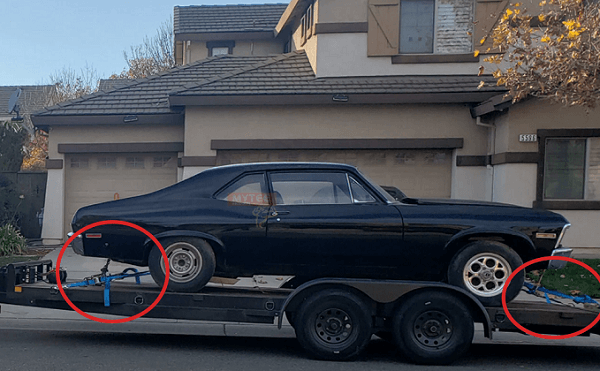
Axle straps are uniquely designed to secure vehicles by being attached to the front or rear axles. Axle straps come in a variety of lengths and are universal to nearly any vehicle! Axle straps create a securement point at one of the strongest points of a vehicle and come with hooks and mounting rings, which can be used with tools such as E-track rails to prevent your vehicle from shifting, rolling, or coming loose during transit. They also connect to snap hooks in order to be tightened with ratchets.
Pro Tips on Car Tire Straps:
No matter how long you’ve been hauling, it’s always a good idea to learn and refresh your memory on tips and tricks used in the industry that will make your job easier! That being said, here are some pro tips on car tire straps!
- While it’s good practice to check the working load limits of all your auto tie-down equipment, equipment manufacturers can have their own securement specifications and tie-down points on both your tools and vehicles/cargo to remain aware of!
- While it may be enticing to, in a pinch, substitute polyester webbing tire tie-down straps with non-tire straps, chains, or tow rope, this is rejected by professionals and car manufacturers. Vehicle hauling straps are designed specifically for this job, while other chains, straps, and ropes are made for their own specific jobs. You cannot and should not substitute car tire straps if you want to ensure your vehicle will remain secure and safe!
- When loading the vehicle onto the trailer or ramp, ensure it’s completely leveled and centered. Additionally, make sure you secure the vehicle from four different anchor points with at least four tie-downs to help balance the weight during any weight shifting, like sharp turns or hard brakes. Symmetry is key! Car trailer straps work best when they’re secured so weight is evenly distributed.
- There’s nothing worse than arriving at your destination or client and finding scratches around the wheel rims or vehicle itself! Using two rags per auto tie-down or wool sleeve protectors are lifesavers for protecting your vehicle or wheel rims during securement and transportation! Doing this simple trick keeps your cargo scratch-free and your clients happy, increasing your chance of a repeat customer or more jobs!
- It’s a good idea to routinely inspect all of your hauling and tie-down equipment for damage around or on the car tire straps’ webbing for cuts, stretching, or mold. Additionally, check the metal of your hooks and ratchets for any defects or damages since these defects can damage both your tire straps and the vehicle you happen to be hauling at the time. Replace any and all car hauler straps or equipment the moment you find damages or risks; it is better to spend the money on replacements than to have to pay for any damages caused to your cargo or on the roadways.

Car tire straps are an essential tool for all haulers, no matter what type of vehicle you plan to haul and transport. The world of vehicle straps can feel overwhelming, even to seasoned drivers – we hope this article will help with easier navigation so you can find the perfect tire straps for your vehicle and trailer! If you are still confused or have lingering questions, feel free to contact us at Mytee Products customer support or visit our website to browse our car hauling supplies!
FAQs
If you’re just getting started in car or auto hauling, you likely have a lot of questions about the do’s and don’ts in the industry. We answer some of the most common questions surrounding tire tie-down straps below, but if you find yourself still confused or left with an unanswered question please don’t hesitate to reach out to our customer service, where we’ll be happy to answer your remaining questions!
Following DOT regulations, you should always secure any vehicle by at least four anchor points. Ensuring these points are equally spaced will ensure there is equal weight distribution and help prevent your vehicle from shifting during hard stops or turns.
Car tie-down chains are only really used for securing a vehicle by the frame. You will find a variety of chain lengths and types of hooks that work with different automotive brands, but unless your trailer is built with securement points for chain tie-downs it’s safer to invest in strap systems. Straps are more versatile for hauling and are designed to be secured by the axle or wheels, which throws out the need for buying specific hooks for the brand of vehicle you may be hauling that day.
Thanks to their versatility, most car trailer straps fit your standard car and truck vehicle wheels. You will only find complications with our tire straps if your vehicle has abnormally large or small tires, is oversize or overweight, or your trailer is longer than your vehicle. If you don’t see this as being an issue for the vehicles are cargo you plan to haul, it is more important to consider the type of tire tie-down and trailer style than the size of car hauler straps.
Inspecting for damages to tire straps is relatively simple!
First, check the strap itself. Good quality tire straps should have safety and inspection information sewn on the tag; follow the safety and inspection instructions listed there.
Next, routinely check the straps for tears, noticeable stretching, and wear. The best rule is that if it looks worn or torn, DON’T use it! Examine your car hauler straps and ratchet devices every single time before you begin securing vehicles.
When used properly secured and inspected for damage as instructed, your car trailer straps should last you years! Wheel straps typically fail or break faster when they are wrapped, twisted, or pulled over sharp corners, improperly or irregularly inspected, or exceed their working load limits. Never exceeding your tire straps limits, proper storage away from direct sunlight and moisture, avoiding sharp corners, and consistent inspection for damages will ensure your car tie-down straps remain a reliable and long-lasting hauling investment!



